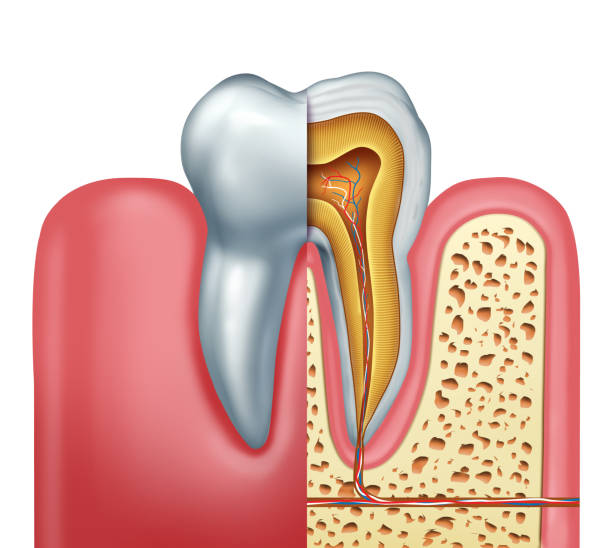In a world where the complex machinery that resides within our mouths is sometimes taken for granted, learning about the anatomy of teeth and the oral cavity is an incredibly interesting experience. Experienced dentist Dr. Chirag Chamria of Royal Dental Clinics leads us on an insightful tour, illuminating the mysterious parts of our teeth and mouth that are vital to our general well-being.
Dynamic Mouth | Parts of Teeth
Gums and Their Role
Gums, also known as gingiva, are vital parts of your mouth, doing more than just framing your teeth. They act as a protective barrier, defending against bacteria and stopping possible infections that might harm your overall oral health. Additionally, their sturdy foundation is crucial for keeping your teeth stable and aligned

In order to detect changes in color, texture, and bleeding in the gums—early warning signs of possible health problems—regular gum inspections are essential during dental check-ups.
Lips
The lips are important for dental health and function, but they are also frequently disregarded cosmetically. Lips are essential for speech articulation, mouth cavity closing, and avoiding over-drying of the oral tissues. Lips that are moisturized well help to promote general oral comfort.
To shield your lips from sun damage, avoid dryness, and maintain the best possible oral comfort, use a lip balm with SPF.
Tongue
A complex network of taste receptors on the tongue, an amazingly adaptable organ, interprets the tastes we encounter on a regular basis. The functioning of taste buds is revealed to be a complicated interaction of receptors that identify umami, bitter, sour, salty, and sweet sensations. Taste buds provide benefits for dental health beyond just enjoyment.

Maintaining optimal tastebud function requires proper hydration, so make sure you get enough water to support your senses.
Speech and Swallowing
The tongue’s adaptability goes beyond taste; it is essential for swallowing and speaking. Oral health specialist Dr. Chirag Chamria stresses the need of treating tongue-related problems for general health.
To improve tongue strength and flexibility, include easy tongue workouts into your regimen by following the advice of expert Dr. Chamria.
Basics of Tooth Structure
Enamel: Protective Shield
Our teeth’s enamel is the outermost layer that protects them from life’s abrasions and daily wear and tear. Its crucial function in preventing tooth decay cannot be emphasized. Enamel, the toughest material in the human body, is mostly composed of minerals and acts as an impenetrable barrier against acidic assaults, temperature changes, and chewing pressures.
Frequent dental examinations are essential for identifying early enamel degradation indicators and ensuring prompt treatment. Use toothpaste with high fluoride content as part of your dental hygiene regimen to fortify enamel and improve its shielding qualities.
Dentin: The Supportive Layer
Dentin, a thick tissue that makes up the majority of a tooth’s structure, is located underneath the enamel. It, although not as hard as enamel, is essential for maintaining the tooth’s overall structural integrity. It has tiny tubules within that provide signals to the nerves, linking our teeth to the senses we use on a regular basis.

Dentin sensitivity, which is frequently felt as discomfort while eating hot or cold foods, may be a sign that dentin tubules have become exposed and require dental care. Regular brushing and flossing are two important aspects of good dental hygiene that help avoid dentin-related problems.
Types of Teeth
Incisors
Primary Function and Arrangement in the Mouth: Incisors are the front teeth with a flat, chisel-shaped edge. Their primary function is cutting or chopping food during the initial stages of the digestive process. They are centrally located in the mouth, with two on the top and two on the bottom.
Common Issues and Preventive Measures: Common problems related to incisors include chipping and enamel wear. Dr. Chamria recommends regular dental check-ups to identify issues early. Using a soft-bristled toothbrush and avoiding biting hard objects can help prevent damage to incisors.
Canines
Unique Features and Importance in the Oral Cavity: Canines, often referred to as “fangs,” have pointed edges and are designed for tearing and grasping food. Their unique features include a more extended root and a sharper tip. Canines play a crucial role in the efficient tearing of tougher food items.
Dr. Chirag Chamria’s Tips for Canine Care: Dr. Chamria recommends maintaining the sharpness of canines by avoiding habits like nail-biting or opening packages with teeth. Regular dental cleanings can also prevent plaque buildup, ensuring the longevity of canines.

Premolars
Grinding and Chewing Mechanics: Positioned behind the canines, premolars have flat surfaces with multiple cusps, allowing them to grind and crush food. Their versatile function involves breaking down food particles into smaller pieces in preparation for swallowing.
Preventing Premolar-Related Problems: Premolars can be prone to cavities and decay due to their chewing function. Dr. Chamria suggests maintaining good oral hygiene, including regular flossing between premolars, and considering dental sealants for added protection.
Molars
Overview of Molars’ Pivotal Role in the Chewing Process: Molars, located at the back of the mouth, have broad surfaces with multiple cusps, making them ideal for crushing and grinding food. Their pivotal role in the chewing process ensures efficient breakdown of food before digestion.
Addressing Common Concerns Associated with Molars: Common concerns with molars include cavities and wisdom tooth impaction. Dr. Chamria recommends maintaining proper oral hygiene, regular dental check-ups, and timely removal of impacted wisdom teeth to address these issues.
Maintaining Oral Harmony
Brushing Techniques
Dr. Chamria stresses how important it is to wash your teeth properly. To guarantee complete cleaning and plaque removal, use circular or back-and-forth motions, being sure to reach all surfaces of the teeth. He suggests using a fluoride toothpaste for efficient cavity prevention and a soft-bristled toothbrush to reduce damage to enamel. Personalized brushing regimens are crucial for the best possible dental health.
Flossing
Food particles and plaque that brushing alone cannot reach are frequently found in the gaps between teeth. In order to lower the risk of cavities and gum disease, Dr. Chamria recommends flossing every day to clean in teeth and the gum line. He busts myths about flossing and emphasizes how important it is for maintaining good dental hygiene and preventing gum disease. Gentle, sliding strokes are used in proper flossing technique to safeguard gums and guarantee thorough cleaning.
Regular Dental Check-ups
Dr. Chamria emphasizes the need for routine dental examinations, ideally every six months. Regular checkups facilitate the early identification of dental abnormalities, enabling prompt treatment and stopping the development of oral health disorders. Dentists are able to detect oral cancer, gum disease, and cavities in their early stages by doing comprehensive exams. Early diagnosis opens the door to less invasive and more effective treatment options.
Conclusion
Finally, our journey through the complex “Parts of Teeth and Mouth” reveals the wonders of our oral environment. Dr. Chirag Chamria highlights the dynamic harmony of oral health by highlighting the symbiotic interaction between the tongue, gums, and teeth. Let’s take preventative care seriously as guardians of our smiles, value routine examinations, and appreciate the subtleties of taste, speech, and general health. To get a beautiful smile, keep in mind that you must first comprehend and take care of all of your “Parts of Teeth and Mouth.” Your investment in dental health is an investment in robust oral health and a lifetime of self-assured smiles.






